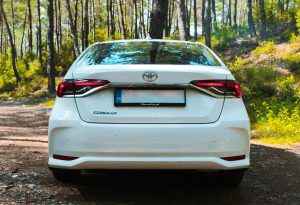
Polestar 4: Bold Innovation or Confused Identity?
Polestar continues to position itself not merely as a premium electric vehicle brand, but as one built upon the principles of purity, performance, and progressive design. These three pillars underpin the ethos of the new Polestar 4 – a vehicle that boldly blends multiple identities into a single, daring package.
Described as a mid-size SUV-coupé, the Polestar 4 defies conventional categorisation. It carries hints of SUV practicality, the elegance of a four-door coupé, the refinement of an executive saloon, and the agility of a performance car. There’s also a tech-forward feel that elevates it into the realm of modern digital devices. The result? A vehicle that could either be a masterstroke of creativity – akin to a Picasso on wheels – or a patchwork of conflicting ideas more reminiscent of Frankenstein’s monster.
As expected from Polestar, the 4 is fully electric. It’s built on Geely’s SEA platform, which it shares with the Volvo EX30, Smart #1, and several lesser-known Zeekr models – and even the Lotus Emeya, albeit more distantly.
Under the sleek bodywork lies a 94kWh nickel-manganese-cobalt battery. Buyers can choose between a single rear-mounted motor offering 268bhp and 253lb ft of torque, or a dual-motor setup delivering a formidable 536bhp and 506lb ft. The single-motor variant is expected to appeal to those prioritising efficiency, with a WLTP range of up to 385 miles.
Charging performance is competitive, with a maximum capacity of 200kW enabling a 10 to 80 percent top-up in just 30 minutes. Vehicle-to-load functionality is standard, allowing the car to power external devices – a useful feature that’s becoming increasingly popular.
From a design perspective, the Polestar 4 is striking, measuring 4.84 metres in length and standing 1.53 metres tall. While its pricing starts around £60,000, it competes with premium EVs such as the Porsche Macan, BMW iX2, Audi Q6 E-tron, and the ubiquitous Tesla Model Y – a model that, despite its shorter dimensions and slightly lower price tag, dominates the electric SUV market.
Yet, the 4’s sloping roofline and aerodynamic profile arguably align it more closely with models like the BMW i4 and Hyundai Ioniq 6. In fact, its roof stands just 2cm taller than that of the Mercedes-Benz EQE. This design-centric approach means it often resists classification as a conventional SUV, instead occupying a unique, liminal space in the EV landscape.
On the road, the 4 delivers solid performance but stops short of a full dynamic breakthrough. It lacks some of the fine-tuning typically associated with Polestar’s previous models. The ride quality and cabin refinement could also see improvement, and while the car’s digital rear-view system is a novel feature, it remains a polarising solution with both benefits and drawbacks.
Inside, the multimedia interface feels somewhat unintuitive – a surprising misstep given the car’s tech-heavy leanings. Meanwhile, the styling, though undeniably original, doesn’t quite match the visual impact of the Precept concept car that inspired it. Nor does it offer the same immediate appeal as the smaller, more approachable Polestar 2.
Still, the 4 has plenty to commend it: a strong electric range, eye-catching design, and a price that becomes more competitive once options are factored in. It’s an ambitious entry that challenges the norms of its segment, even if it doesn’t entirely rewrite the rulebook.
In short, the Polestar 4 is a bold experiment – one that blends diverse elements with varying degrees of success. Whether it’s a work of automotive art or a stylistic curiosity will depend on your perspective. Either way, it signals that Polestar remains a brand unafraid to push boundaries.















